Corn: How to Offer Corn Safely to Your Baby
- Corn kernels - why babies should not be fed small individual corn kernels early on in feeding; but how you can adapt corn into a BLW recipe that babies can safely self-feed
- Corn on the cob - why we don't offer baby corn on the cob until there is at least 1 tooth to help maximize independence in self-feeding
- Cornmeal - how homemade polenta is one of the easiest baby foods you'll ever make and how to adapt a cornbread recipe to make it safe for BLW

LISTEN TO THIS EPISODE
Episode Description
Can babies eat corn? Is corn good for babies? How do I safely offer corn for my baby? In this episode we’re talking all things corn for baby-led weaning: why corn kernels are a choking hazard early on in BLW, when it’s safe to offer your baby corn on the cob, how to use cornmeal for self-feeding and how to adapt a recipe for cornbread to make it ok for your baby to eat.
Links from this Episode
- Baby-Led Weaning with Katie Ferraro program with the 100 First Foods™ Daily Meal Plan, join here: https://babyledweaning.co/program
- Baby-Led Weaning for Beginners free online workshop with 100 First Foods™ list to all attendees, register here: https://babyledweaning.co/baby-led-weaning-for-beginners

Latest Episodes

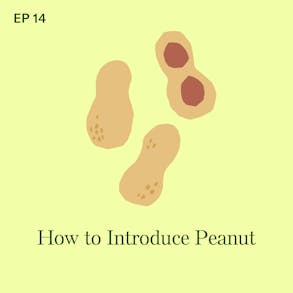
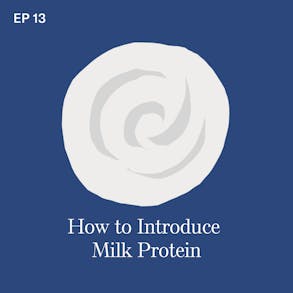
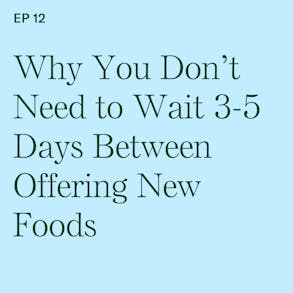
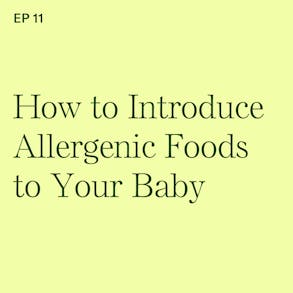
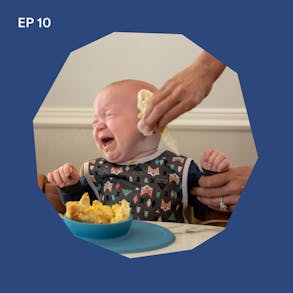
Katie Ferraro (0s):
And so corn is a fabulous food from a nutrition standpoint, from a taste and texture standpoint, but we certainly don't do corn on the cob early on in feeding. And we don't serve babies individuals, small kernels of corn early. There are way safer ways to do corn early on in baby-led weaning. Hey there, I'm Katie Ferraro, Registered Dietitian, college nutrition professor, and mama of seven specializing in baby led weaning. Here on the Baby-Led Weaning Made Easy podcast I help you strip out all of the noise and nonsense about feeding, leaving you with the competence and knowledge you need to give your baby a safe start to solid foods using baby led weaning. Hey guys welcome today. We're going to be talking about corn and how do you introduce corn safely to your baby? Now I love corn for baby-led weaning, but it can be a tricky food. So there are a few nuances. I want to point out about corn. For those of you guys who are avid listeners of the baby led weaning made easy podcast, you might be aware that I do two episodes a week.
Katie Ferraro (1m 3s):
So Monday is a mini baby-led weaning training episode of which this one is. And then Thursday, I always do a guest expert interview talking to someone in the field of feeding or nutrition or food on these mini BLW training ones though. I love to start out with a baby led weaning tip of the day. And because we are talking about corn, I sometimes will get questions from parents about, oh my gosh, my baby had corn. And then I'm seeing corn in the stool. Is that a problem? If the corn is like passing through into my baby's diaper and I want to let you know that the answer is no, it happens with adults sometimes, right? There are certain components of food that are more challenging to digest, or we don't completely digest, but that's the point of having a well functioning excretory system is that your body's doing its job by excluding the stuff it can't handle.
Katie Ferraro (1m 48s):
Now, does that mean you should not be feeding corn to your baby? No, absolutely not. Your baby still. If they did eat any of it. And remember early on in baby led weaning, there's not a ton of actual eating going on, but as your baby becomes more proficient in self-feeding, they will start to eat and then swallow and then digest some of that corn. But you might still see some changes in the diaper, some actual intact pieces of corn. And that's not an indicator that you should not be feeding that food or that your baby's not digesting or handling it. You should be concerned if you ever see blood in your baby's stool though. That's certainly a reason for concern, but intact pieces of corn, not a problem. So let's go ahead and dive in talking about corn and how to offer corn safely to your baby.
Katie Ferraro (2m 30s):
So let's get started by talking about what corn is, or maybe first what corn is not. Cause sometimes I'll get questions from parents and caregivers like, is corn good for you? I thought corn was not good for you. Here's the deal with corn. Corn is like many foods are fine for babies to have. There's nothing harmful about corn. And it's not one of the major allergenic foods. If it were, that wouldn't really matter because we still introduce babies to allergenic foods. But sometimes parents are concerned about corn allergy. Corn allergy is certainly not one of the most prevalent food allergies by any stretch of the imagination, you could be allergic to corn, just like you could be allergic to any food, but we don't have good hard data about corn allergy because it there's just not that much of it out there. So corn from the nutrition standpoint, it is a good source of carbohydrate.
Katie Ferraro (3m 12s):
And if we look at carbohydrates, fats and proteins, they're all important for babies, but the majority of babies calories, as they're transitioning to getting more nutrition from food and less from milk will become more reliant on carbohydrate used to be really high in fat in the breast milk and formula phase. Now we're getting carbohydrate as well as protein and fat. So we need a variety of sources of carbohydrate and corn is a great one. Corn also has a good amount of fiber in it. It's got vitamin C in it and B vitamins in it as well not to mention the taste and the texture and the flavor opportunities that it's affording your baby. So corn, no problem with feeding our baby corn from a nutrition standpoint. Now what about when to feed babies corn? We'll talk a little bit about the different variations in which you can feed corn, but I personally do not feel comfortable doing corn on the cob for, until that baby has at least one tooth.
Katie Ferraro (3m 60s):
Now I want to point out you do not need teeth to start baby led weaning, but there are some foods that are simply easier for babies to eat when they actually do have a tutor or two and corn on the cob is one of them. I personally, there's nothing more adorable than watching a baby go to town on a corn cob end, once your babies get a little bit older and they've got teeth and they're comfortable heating a variety of different foods, corn cobs are ones that keep babies occupied for infinite amount of time. So if you need to buy yourself a little time, obviously we never leave our babies unattended at the high chair, but corn on the cob is a great one. Now what about the little kernels of corn? I also don't do those for earlier eaters because when your baby is six or seven months of age, they don't have their pincer grasp to pick up the little kernels of corn yet, even if they could and got them into their mouth.
Katie Ferraro (4m 46s):
Like if you put them on a spoon and shoved it into the baby's mouth, the very small kernel size is exactly the size of a piece of food that could potentially occlude your babies airway and pose a choking hazard. So we do not do small, tiny corn kernel shaped pieces of food early on in baby led weaning again a because babies can't pick them up and feed it to themselves. So we want to feed more age appropriate foods early on. And furthermore, we need baby to be practicing on those longer strips and spheres of food before we move them into the smaller pieces, which comes a little bit later in feeding. So hold off on the corn, on the cob until they have a tooth or two, and then hold off on the kernels of corn by themselves until the baby has been practicing for a period of time, such that you feel comfortable, that they can handle smaller pieces without choking, and also that they can pick it up and feed it to themselves.
Katie Ferraro (5m 34s):
So then how do we do corn for babies early on in weaning? If you want it to feed corn to your baby at six and seven months, we'll have two suggestions for you. I love corn meal, right? So corn meal is ground up. Corn can be used in a variety of different ways. I love to make polenta out of cornmeal. Polenta is one of my favorite first baby foods. I don't buy it. Commercial polenta though. The kind that you see in a tube at store, it just has too much sodium, but it's very easy to make polenta yourself with boiling water and corn meal. You can make it then into kind of a thick porridge like consistency that you could offer baby on a preloaded spoon where I actually wait until it cools a bit, then I cut it into patties. I fry them and then cut those into strips and serve that to the baby.
Katie Ferraro (6m 16s):
Another option for how you might want to feed your baby corn meal is with corn bread. Now, again, we don't generally do commercial bread products for babies because the sodium is too high, but you can find recipes to make corn bread for your baby. That would not have too much sodium. Also, you want to keep an eye out for honey. A lot of the recipes for corn red would have honey. And please remember we don't feed babies honey, prior to one year of age, that's because of the potential for botulism risk. So if a recipe has like one or two tablespoons of honey, I'll just sub a agave syrup, don't do generally added sugars for babies agave. I kind of go back and forth with it. It's not technically an added sugar, but it is a concentrated source of sweetness. But again, in very small quantities spread out after over an entire like skillet recipe of corn bread, I'm comfortable with one or two tablespoons of a agave syrup in a recipe for a food.
Katie Ferraro (7m 5s):
I would feed my baby. Having said that about corn bread, I do want to point out it can be very dry. So find a recipe that has a lot of fat and a lot of oil to make it moist. And we don't serve dry bread products to babies early on in feeding, you would definitely want to moisten that up with a dipper or a topper. I sometimes add a lot of melted butter butter, of course, being a dairy product, meaning it has cows milk protein in it. So you want to make sure your baby has been exposed to cow's milk protein foods. A number of times, without reaction before you would add butter onto corn bread. If that was the new food of the day, the corn bread, that is, I also like to do ricotta cheese on top of corn bread as a way to soften it up and kind of make it less dry. Ricotta is a cheese again, a dairy product, but that tends to be much lower in sodium than many other cheeses.
Katie Ferraro (7m 46s):
One of my favorite go-to baby led weaning breakfast is corn bread with some ricotta spread on top of it. Corn meal in the corn bread is a great way to introduce your baby to corn. Another thing you can do for the introduction of corn is if you have kernels of corn can work them into a fritter or a patty recipe with other ingredients that the baby's already had fry that up, cut it into strips, serve the strips to your baby who can then pick it up, take off a bite. Even if they take off a small bite in their mouth. They're the ones who are in control, right? That's the point of baby led weaning that the baby is driving the feeding experience. And then in that case, the baby can be moving the food around their mouth. They're the ones they might spit a little bit out at first, but as they get more proficient, they'll then be learning how to chew and how to swallow.
Katie Ferraro (8m 28s):
So you could do corn bread. You could do polenta, you could do a corn fritter or a corn patty cut into strips for your baby. But I suggest holding off on the small individual kernels of corn until your baby's a little bit older and certainly has their pincer grasp. And then also holding off on corn on the cob until the baby has a few teeth. Just be much more efficient at eating that food. So there you have it, just a couple of tips on how to safely offer corn to your baby. Bye now!
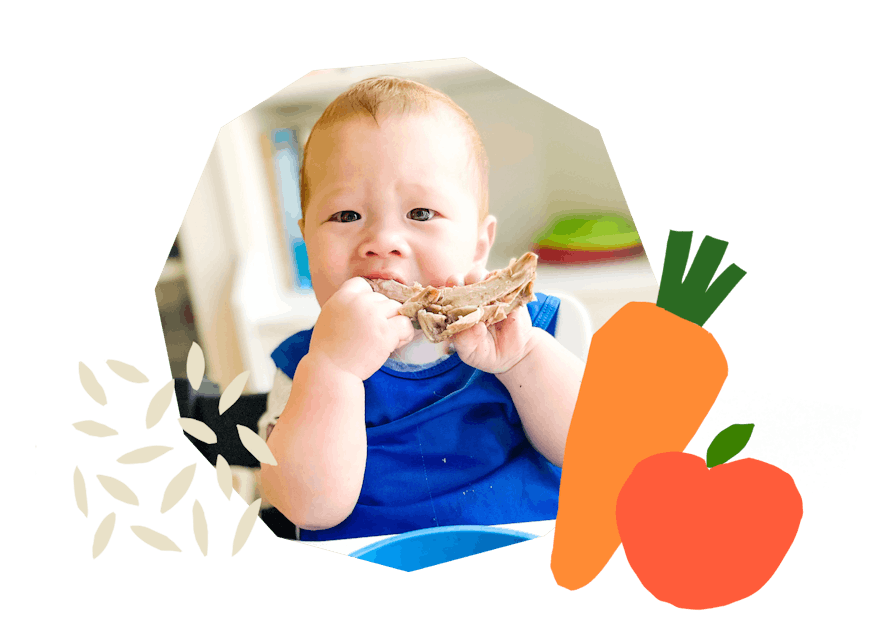
The Program Baby-Led Weaning with Katie Ferraro
A step-by-step digital program for starting solid foods safely and navigating the original 100 FIRST FOODS™ meal plan with baby-led weaning.
 EXPERT-LED, PROVEN APPROACH TO EATING REAL FOOD
EXPERT-LED, PROVEN APPROACH TO EATING REAL FOOD CONCISE VIDEO TRAININGS TO MASTER BABY-LED WEANING
CONCISE VIDEO TRAININGS TO MASTER BABY-LED WEANING 100 FIRST FOODS DAILY MEAL PLAN WITH FOOD PREP VIDEOS
100 FIRST FOODS DAILY MEAL PLAN WITH FOOD PREP VIDEOS
Baby-Led Weaning for Beginners Free Workshop
Is your baby ready to start solid foods, but you’re not sure what to do? Register for this free online video workshop and learn how to give your baby a safe start to solid foods using baby-led weaning. Everyone on this free training receives a copy of Katie’s original 100 FIRST FOODS™ list. You can take this workshop right now, later today when your baby naps, or tomorrow…whatever works for you!
Get baby-led weaning recipes and tips delivered to your email inbox.